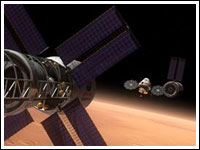
Cosmic radiation could accelerate the onset of Alzheimer’s disease among astronauts, adding to the health risks it’s already known to pose.

Researchers at the University of Rochester Medical Center’s School of Medicine and Dentistry looked at the effect of high-mass particles with a high charge. These so-called “HZE particles” are the nuclei of elements that include iron, silicon, titanium and calcium.
Exposure to these particles increases with the duration of a spaceflight, the study found. This could be a concern for NASA, which is planning manned missions to Mars.
However, the findings may not have much of an impact on NASA’s plans.
“Our work simply adds an additional potential health-risk factor that NASA will need to consider,” Kerry O’Banion, professor of neurobiology and anatomy at URMC, who led the study, remarked. “I don’t believe that this single finding will impact their plans or how they will address these risks.”
Some Details of the Study
The researchers selected iron particles for the study because their mass, combined with their speed, let them penetrate solid objects such as the walls and protective shielding of spacecraft. At the NASA Space Radiation Laboratory at Brookhaven, they exposed mice to various doses of radiation, including levels comparable to what astronauts would experience during a trip to Mars. The mice were then required to recall objects or specific locations.
The test subjects were far more likely to fail their tasks, and their memory lapses appeared earlier than they normally would in other mice. The brains of the mice showed signs of vascular alterations — meaning changes in the blood vessels — and higher levels than normal of beta amyloid, an amino acid compound. Both are indicators of Alzheimer’s disease.
However, “our dose was given over a very short time period,” O’Banion told TechNewsWorld. “Astronauts will be exposed to a chronic low dose that might have very different biological effects.”
In Space No One Can See You Glow
HZE particles make up 3 percent of the fluence, or the measure of particles that strike a spacecraft, NASA spokesperson Rachel Kraft told TechNewsWorld. Protons account for 87 percent and helium for the other 10 percent. However, HZE particles have very high energy and are highly charged, so they “make higher contributions to the dose and risk than indicated by the fluence.”
Astronauts “are very much aware of the risks associated with space travel, but they have a strong drive to explore and discover, even if the job can be hazardous,” Brian Shiro, CEO of Astronauts4Hire, told TechNewsWorld. “Space exploration drives not only advancements in science and engineering, but it also provides direct benefits to life on Earth. That’s well worth the risk.”
The study “is a marker and reminder that space radiation can cause possible health problems, either immediately or earlier in the aging process,” Kraft remarked. “At this point, the information is too preliminary and does not provide sufficient quantitative information to project the risks, if any, of early occurrence of Alzheimer’s disease … for a Mars mission.”
NASA is working with the nation’s best neuroscientists to solve the long-term problem of risks to astronauts’ central nervous systems, Kraft stated.
“We have long known that the interplanetary environment carries dangers for unprotected astronauts,” Alexander Saltman, executive director of the Commercial Spaceflight Federation, said.
“It is great that researchers are taking a long hard look at that environment so we know as much as possible when we venture out into interplanetary space,” Saltman told TechNewsWorld. “I have no doubt that, should these results be confirmed by follow-on studies, they will play a role in how NASA and private companies design future spacecraft.”





















































